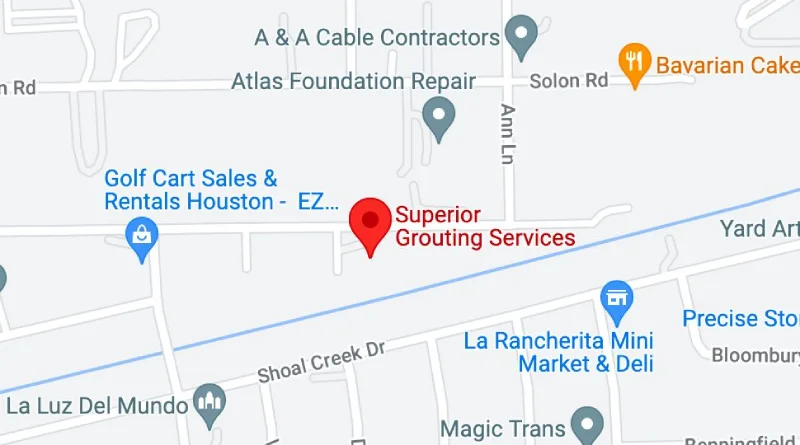What Is Tunnel Grouting in Beaumont, TX?

In Beaumont’s busy refining corridor, tunnel grouting is more than a construction buzzword—it is the geotechnical backbone that keeps freight rail, utility galleries, and conveyor corridors open and dry. Simply put, grouting involves the injection of engineered mixtures into surrounding soil or rock mass to fill voids and stabilize the ground before, during, and after excavation. Superior Grouting has refined this science for Gulf Coast conditions where high groundwater, loose soil, and corrosive environments can threaten structural integrity if left unmanaged.
Key Takeaways
- Tunnel grouting in Beaumont is critical for stabilizing loose soils, controlling groundwater, and ensuring long-term structural integrity in industrial and transportation infrastructure.
- Pressure grouting transforms unstable ground into a load-bearing foundation by injecting cement-based, chemical, polyurethane, or cellular concrete mixtures.
- Ground improvement, water control, and asset longevity are the three main benefits, especially in the Gulf Coast’s high groundwater and variable soil conditions.
- Material selection—cement grout for heavy loads, polyurethane for rapid water cut-off, or chemical/cellular solutions for specialized conditions—depends on project needs and site geology.
- Advanced techniques like compaction, permeation, jet grouting, and cellular concrete placement allow engineers to tailor solutions for tunnels, foundations, and rehabilitation projects.
Understanding Grouting and Its Role in Tunnel Construction
Pressure grouting is a process that seals water ingress, improves load-bearing capacity, and prevents ground loss around bored or cut-and-cover tunnels. When grout materials—cement-based slurries, polyurethane foam, cellular concrete, or chemical solutions—are injected, they solidify in place, creating a dense, low-permeability matrix. This matrix distributes loads evenly, protecting precast liners, steel ribs, and surrounding infrastructure against settlement or uplift.
The role of pressure grouting extends beyond simple gap filling; it is a key soil stabilization method that converts unpredictable strata into a solid foundation capable of supporting long-term industrial use. By integrating pressure gauges, data loggers, and high-pressure pumps, contractors maintain precise pressure control, ensuring the injected grout does not fracture the ground yet fully penetrates every hidden void.
Why Pressure Grouting in Tunnels Matters Along the Gulf Coast
Beaumont sits at the heart of the Gulf Coast’s alluvial plain. Here, groundwater rests just a few feet below grade, and stratified sands alternate with compressible clays. These conditions make water seepage, soil instability, and structural damage recurring threats.
Pressure grouting in tunnel construction offers three immediate benefits:
- Ground improvement: Grout mixture permeates loose soil, compaction grouting densifies sands, and jet grouting creates soil-cement columns—each increasing the capacity of the ground to carry industrial loads.
- Water control: Permeation grouting forms an impermeable curtain that resists water pressure, eliminating unexpected inflows that can jeopardize a tunnel boring machine or disrupt the overall construction process.
- Longevity of tunnel assets: A well-designed application of pressure grouting significantly extends service life by guarding liners against corrosion, abrasion, and chemical attack from aggressive groundwater.
Core Solutions in Pressure Grouting: Techniques Used in Beaumont
Engineers rarely rely on a single grouting method. Instead, they combine various techniques of pressure grouting to match site-specific soil conditions:
1. Cement Grouting
This classic approach uses Portland or microfine cement to fill gaps, seal joints, and improve durability. Cementitious mixtures work best in coarse sands and gravels where pore spaces are large enough for grout travel.
2. Chemical Grouting
When silts are too tight for cement, sodium silicate or acrylic gels are injected. These chemical solutions solidify rapidly, offering high early strength and minimizing water seepage through fine soils.
3. Polyurethane Injection
Lightweight polyurethane foam expands on contact with water, filling voids and consolidating fractured zones without adding excessive weight. Polyurethane is ideal for rapid water cut-off or emergency repairs in active tunnel projects.
4. Jet Grouting
A high-velocity jet erodes in-situ soil and mixes it with grout, creating a homogeneous soil-cement column. This technique delivers excellent pressure grouting techniques for underpinning existing structures or forming complete cut-off walls.
5. Cellular Concrete Placement
For large annular spaces, low-density cellular concrete offers uniform support while reducing dead load. Its air-entrained composition improves thermal properties and resists shrinkage, bolstering the longevity of tunnel linings.
Step-by-Step Pressure Grouting Process
- Site Investigation – Geotechnical engineers log boreholes, map soil strata, evaluate water pressure, and identify zones requiring ground improvement.
- Grout Design – Laboratory trials establish water-cement ratios, additives, and expansion rates tailored to Gulf Coast groundwater chemistry.
- Drilling and Sleeve Installation – Tube-à-manchette sleeves or steel casings are drilled into surrounding ground, preparing pathways for high pressure injection.
- Injection Phase – High-pressure pumps deliver grout while pressure gauges record each stage. If a sudden spike appears, the crew slows flow to prevent hydro-fracturing. This careful pressure control is fundamental—pressure grouting is a highly precise endeavor where real-time adjustments protect the surrounding soil.
- Verification and Secondary Grouting – Core samples, permeability tests, and CCTV inspections confirm the effectiveness and safety of the grouting work. Any soft zones trigger additional injection to secure full coverage.
Polyurethane Foam vs. Cement-Based Grout: Choosing the Right Material
The selection of grout materials hinges on project constraints:
- Need for speed: Polyurethane foam reacts within seconds, making it perfect for emergency water ingress mitigation.
- Long-term strength: Cement-based grout excels in bearing heavy loads, crucial for freight tunnels or deep industrial utilities.
- Environmental exposure: Chemical grouts resist sulfates common in Gulf Coast soils.
- Space constraints: Cellular concrete spreads easily through complex profiles, filling voids and stabilizing annular gaps with limited access.
Safety, Quality, and Durability
Safety of the grouting operation starts with certified crews who follow confined-space protocols and continuously monitor gas levels in shafts. Grout batching plants feature automatic mixers and redundant pumps to maintain quality and durability under demanding field conditions. Real-time digital logs offer a transparent record of volume, density, and pressure—critical proof that pressure grouting plays its intended role in protecting structural integrity.
Selecting a Grouting Partner in Beaumont
Industrial owners evaluating foundation repair or tunnel rehabilitation should prioritize contractors with:
- Proven pressure grouting process experience in Gulf Coast geology
- Advanced grouting equipment with telemetry for remote pressure control
- Documented success injecting grout under live rail or pipeline corridors without service interruption
- Commitment to safety culture, including OSHA training and spill containment for chemical systems
A qualified partner like Superior Grouting not only delivers technical prowess but also shields owners from schedule overruns and future settlement claims.
Conclusion
In Beaumont, the use of pressure grouting is a key safeguard for infrastructure construction. Whether injecting cement grout to fill voids and stabilize erodible sands, or deploying polyurethane to block sudden water ingress, the technology transforms unpredictable ground conditions into a solid, load-bearing envelope. By embracing advanced grouting solutions, industrial stakeholders ensure tunnels remain serviceable, safe, and resilient for decades along the ever-busy Gulf Coast.


